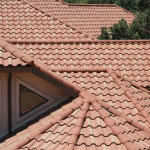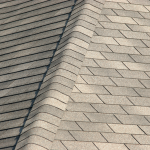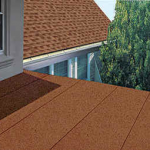As a home inspector in the Phoenix area I see many different types of roofing. The most common are concrete tile, composition asphalt shingles, and rolled asphalt roofing. Some of the other types I see are clay tile, foam, tar and gravel, wood shingles, metal, and EPDM (rubberizes). In this article I am going to discuss the first three most common types.
Concrete Tile
 The advantages of concrete tile roofing are they have a long lifespan, require low maintenance, and are resistant to rot and insects. Concrete is more expensive than most roofing materials, but last longer. Early types of concrete tile roofing had problems with the material cracking and the color often faded. Technology has improved, style and color choices are expanding, and by mixing the cement with additives, manufacturers are making lighter and lighter products that are stronger. Its expected lifespan (50+ years) is greater than the lifespan of the underlayment material typically installed below the tile. In most cases, in new construction just one layer of 30# felt is installed below the tiles. If the tile roof is well maintained and vented properly the roof felt / underlayment will last 25+ years.
The advantages of concrete tile roofing are they have a long lifespan, require low maintenance, and are resistant to rot and insects. Concrete is more expensive than most roofing materials, but last longer. Early types of concrete tile roofing had problems with the material cracking and the color often faded. Technology has improved, style and color choices are expanding, and by mixing the cement with additives, manufacturers are making lighter and lighter products that are stronger. Its expected lifespan (50+ years) is greater than the lifespan of the underlayment material typically installed below the tile. In most cases, in new construction just one layer of 30# felt is installed below the tiles. If the tile roof is well maintained and vented properly the roof felt / underlayment will last 25+ years.
I did a home inspection on a house in Scottsdale that was 15 years old. The underlayment material on this house was deteriorated due to the heat and needed to be replaced. The deterioration was due to poor ventilation in the attic and the tiles not being properly maintained by replacing cracked and damaged tiles and flashings. Stains observed on the underside of the roof decking in the attic were indications that the roofing felt was at the end of its useful life. Replacing the roofing felt is expensive and labor intensive due to all the tiles have to be removed and then replaced after the new underlayment is installed.
Composition Asphalt Shingles
 Composition shingles come in a variety of colors and styles, are fairly durable and can be easily be repaired and maintained. The thicker and naturally more expensive roofing shingles are called an architectural shingle and can last up to 30 years. Even though most composition singles come with a 25-30 year warranty, I typically see this type of roofing needing to be replaced around 15 to 20 years due to the extreme heat in Phoenix. The most common problems I see with shingled roofs are missing tabs due to wind and deteriorated sealant around roof penetrations. I have had several clients ask if they can replace a worn shingle roof with tiles. In most cases you cannot. The roof framing is not typically designed to carry the additional weight of the tiles.
Composition shingles come in a variety of colors and styles, are fairly durable and can be easily be repaired and maintained. The thicker and naturally more expensive roofing shingles are called an architectural shingle and can last up to 30 years. Even though most composition singles come with a 25-30 year warranty, I typically see this type of roofing needing to be replaced around 15 to 20 years due to the extreme heat in Phoenix. The most common problems I see with shingled roofs are missing tabs due to wind and deteriorated sealant around roof penetrations. I have had several clients ask if they can replace a worn shingle roof with tiles. In most cases you cannot. The roof framing is not typically designed to carry the additional weight of the tiles.
Asphalt Rolled Roofing
 Asphalt roll roofing is an inexpensive roofing material commonly used for low pitched roofs. The surface and lifespan is comparable to that of an asphalt shingle. Rolled roofing typically comes in 36” wide rolls and is easy to install if you follow the proper steps recommended by the manufacture. The biggest problem I find with this type of roof is that it was improperly installed by the homeowner or by the homeowner’s “friend”. All seams should be sealed and here should be no wrinkles in the surface. If nails or fasteners are exposed, I recommend caulking the heads to prevent deterioration and leaks.
Asphalt roll roofing is an inexpensive roofing material commonly used for low pitched roofs. The surface and lifespan is comparable to that of an asphalt shingle. Rolled roofing typically comes in 36” wide rolls and is easy to install if you follow the proper steps recommended by the manufacture. The biggest problem I find with this type of roof is that it was improperly installed by the homeowner or by the homeowner’s “friend”. All seams should be sealed and here should be no wrinkles in the surface. If nails or fasteners are exposed, I recommend caulking the heads to prevent deterioration and leaks.


Sorry, comments are closed for this post.